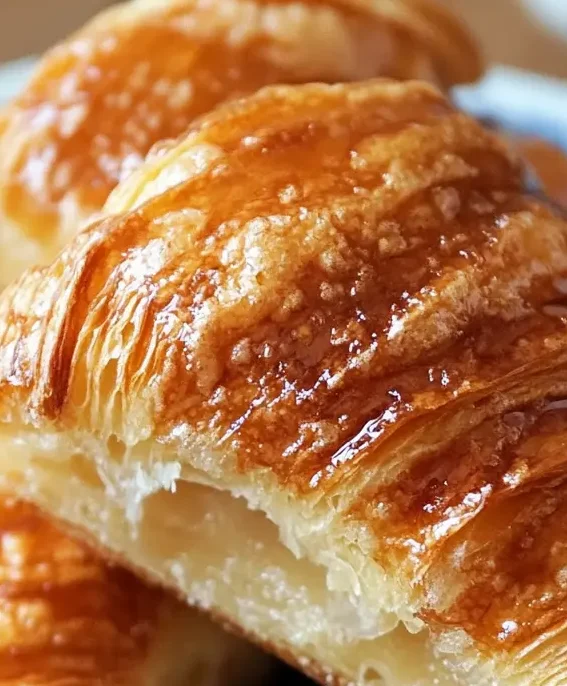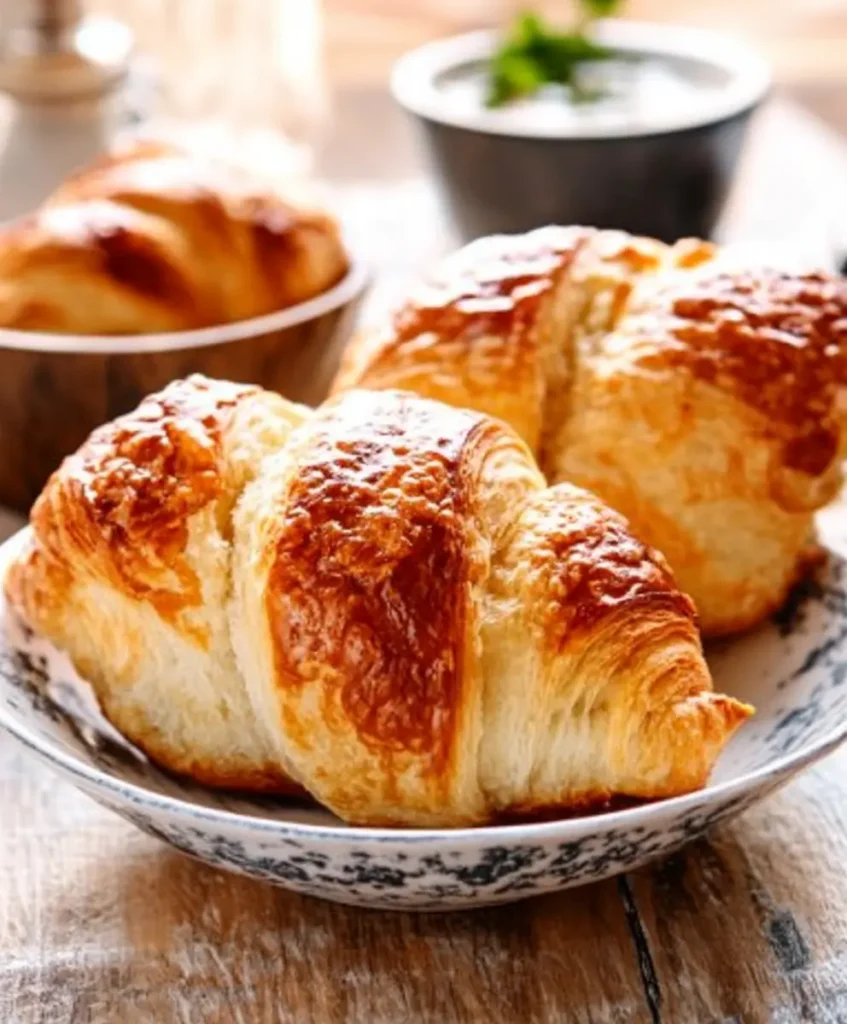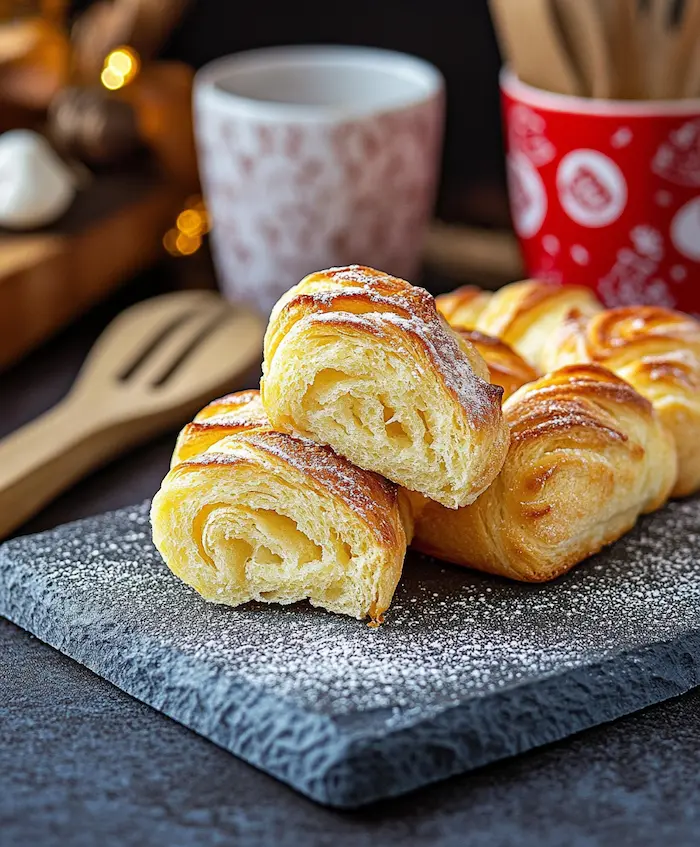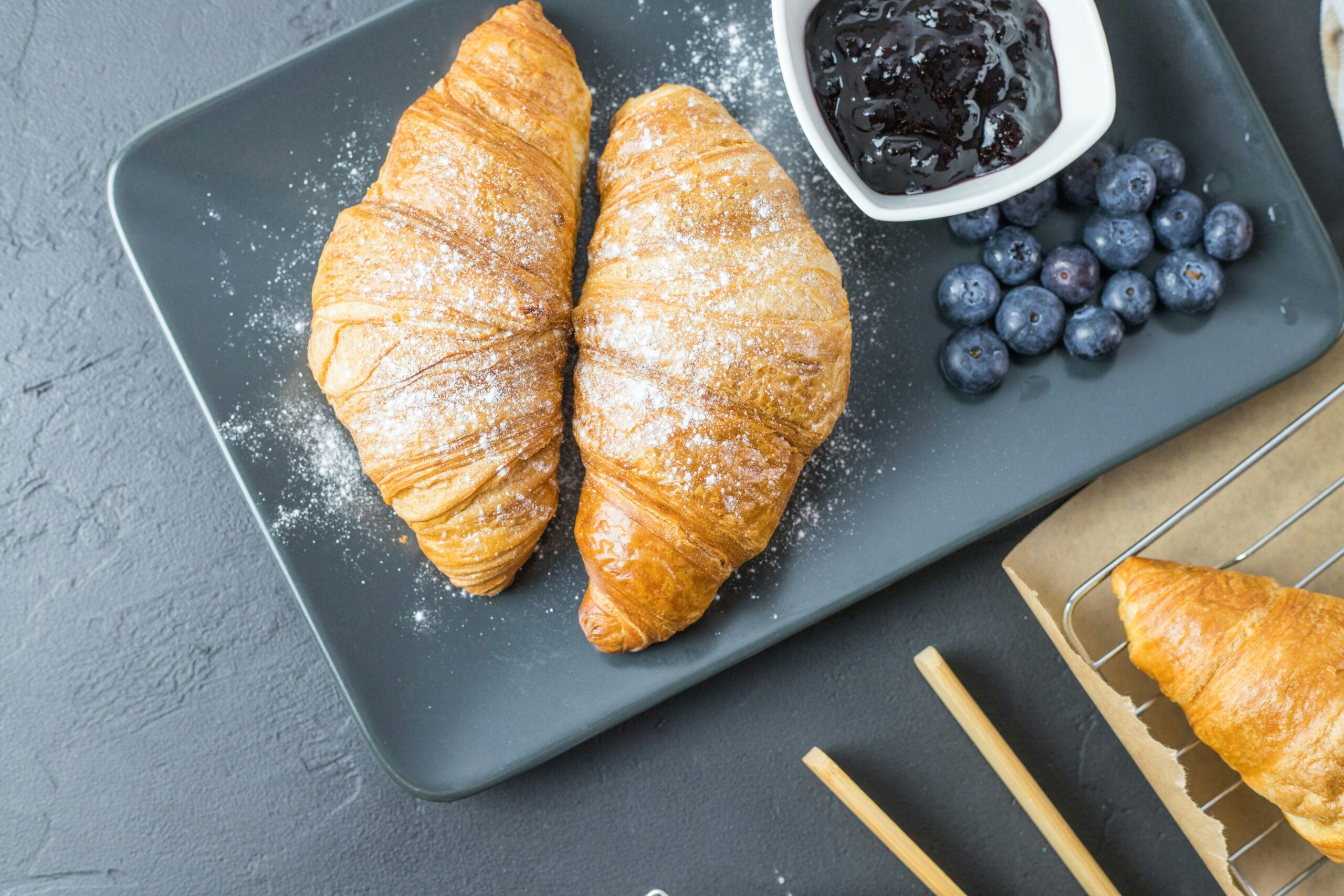Swiss baking enthusiasts will love this step-by-step guide on how to create Soft and Buttery Swiss Gipfeli. These pastries are a delicious treat perfect for breakfast or brunch.
Although the process of making Gipfeli can seem challenging, it’s manageable with the right steps. From choosing quality ingredients to perfecting the rolling and baking, this guide simplifies everything. You don’t need to be a professional baker to create Gipfeli at home. With a little patience, you can enjoy bakery-quality results in your kitchen.
Whether you are an experienced baker or just starting out, this guide is for you. Let’s get started on creating your own batch of Gipfeli that’s soft, buttery, and delicious!
Table of contents
- What is a Gipfeli?
- Ingredients Needed for Perfect Gipfeli
- Step-by-Step Instructions to Bake Gipfeli
- Mastering the Art of Laminating Dough
- Shaping Your Gipfeli
- Baking Tips for Soft and Buttery Croissants
- Common Mistakes to Avoid When Baking Gipfeli
- How to Store and Reheat Gipfeli
- Serving Suggestions for Swiss Croissants
- Why Homemade Gipfeli is Better than Store-Bought
- Frequently Asked Questions
- Conclusion
What is a Gipfeli?
The Swiss Version of Croissants
Gipfeli, or Swiss crescent rolls, are often described as Soft and Buttery Swiss Gipfeli. Unlike French croissants, these pastries are slightly sweeter and denser.
Differences Between French Croissants and Swiss Gipfeli
The biggest difference is in texture and taste. French croissants are flaky and very buttery, thanks to heavy lamination. Gipfeli, however, use less butter and have a tender, bread-like texture. Swiss recipes often include a touch of milk or sugar, giving Gipfeli their mild sweetness.
Ingredients Needed for Perfect Gipfeli
Essential Ingredients
Using quality butter and milk is essential for achieving the perfect texture of Soft and Buttery Swiss Gipfeli. These ingredients create the rich layers we all love:
- Flour: Use all-purpose flour or bread flour for a strong dough structure.
- Butter: Choose unsalted, high-fat butter (at least 82% fat content). Quality butter ensures rich layers and soft texture.
- Milk: Adds a subtle sweetness and softness to the dough. You can use whole milk for the best results.
- Yeast: Use active dry yeast or instant yeast to help the dough rise.
- Sugar: A small amount of sugar adds a mild sweetness and feeds the yeast.
- Salt: Balances the flavor and strengthens the gluten structure.
- Eggs (optional): Eggs can be used for an egg wash to give the Gipfeli a golden, shiny crust.
Why Quality Butter Matters
The butter you use will make or break your Gipfeli. High-fat butter ensures the layers remain distinct and flaky during baking. Lower-quality butter contains more water, which can ruin the lamination process. For Swiss Gipfeli, always aim for unsalted, European-style butter.
Measuring Ingredients Precisely
Precision is key when baking Gipfeli. Small mistakes in measurements can lead to inconsistent results. Use a kitchen scale to measure your ingredients accurately. Baking is a science, and precision helps achieve that perfect soft and buttery texture.

Step-by-Step Instructions to Bake Gipfeli
To make Soft and Buttery Swiss Gipfeli at home, follow these simple steps for preparing, laminating, and shaping the dough:
- Prepare the Dough
- Laminating the Dough
- Shaping the Gipfeli
- Baking the Gipfeli
Each step contributes to creating soft, buttery layers and a golden finish. Let’s start with preparing the dough.
Preparing the Dough
How to Mix and Rest the Dough
- Combine the Ingredients: In a large bowl, mix the flour, sugar, and salt. Dissolve the yeast in lukewarm milk and let it sit for about 5 minutes until it bubbles. Add the milk and yeast mixture to the flour. Mix until a soft dough forms.
- Knead the Dough: Turn the dough onto a floured surface. Knead it for 8-10 minutes until smooth and elastic. The dough should spring back when lightly pressed. If you’re using a stand mixer, knead with the dough hook for 5-7 minutes.
- Rest the Dough: Place the dough in a lightly greased bowl. Cover it with a clean towel or plastic wrap. Let it rise in a warm place for 1-2 hours until it doubles in size. The resting stage allows the yeast to work and develops the dough’s flavor.
Common Dough-Making Mistakes to Avoid
- Water Temperature: Avoid using water or milk that’s too hot, as it can kill the yeast. Aim for lukewarm (around 35-40°C or 95-105°F).
- Not Kneading Enough: Insufficient kneading prevents gluten formation. This can make the dough tough or dense instead of soft.
- Skipping the Rise Time: Rushing the rise process will impact the dough’s structure. Always allow enough time for the dough to double in size.
Mastering the Art of Laminating Dough
Laminating the dough is the key to creating buttery layers in your Gipfeli. It may sound complex, but with the right steps, you can master this technique. Essentially, lamination involves folding and rolling butter into the dough to form thin layers. These layers create the soft, slightly flaky texture Gipfeli are known for.
Steps to Laminate the Dough
- Prepare the Butter Block: Begin by placing cold butter between two sheets of parchment paper. Use a rolling pin to flatten the butter into a rectangle, about 1 cm thick. The butter should be pliable but still firm.
- Chill the Dough: After the first rise, roll the dough into a large rectangle. It should be slightly larger than the butter block.
- Incorporate the Butter: Place the butter block in the center of the dough. Fold the sides of the dough over the butter to enclose it completely, like wrapping a gift.
- Roll and Fold: Roll the dough into a long rectangle. Then fold it into thirds, like a letter. This is the first “fold.” Chill the dough in the refrigerator for 20-30 minutes to keep the butter firm.
- Repeat the Process: Perform 2-3 more folds, rolling and chilling between each one. Chilling is important because it prevents the butter from melting into the dough.
Tips for Perfect Lamination
- Work Quickly: The butter should remain firm at all times. If it softens too much, place the dough in the refrigerator to chill.
- Dust with Flour: Lightly dust the surface and rolling pin with flour to prevent sticking. Avoid using too much flour, as it can affect the dough’s texture.
- Even Thickness: Ensure the dough is rolled evenly during each fold. Uneven layers can result in inconsistent textures.
Laminating may require patience, but the results are worth the effort. By following these steps, you’ll achieve soft, buttery layers that define a perfect Gipfeli.
Shaping Your Gipfeli
Once the dough has been laminated, it’s time to shape your Gipfeli. Shaping determines the final appearance and texture of your croissants. Follow these steps to form the classic crescent shape:
Steps to Shape Gipfeli
- Roll Out the Dough: Roll the chilled dough into a large rectangle, about ½ cm thick. Use a sharp knife or pizza cutter to trim the edges for clean lines.
- Cut Triangles: Divide the dough into triangles. Each triangle should be roughly 10 cm wide at the base and 15-20 cm tall.
- Stretch the Triangles: Gently stretch each triangle to make it slightly longer. This ensures the Gipfeli rolls tightly and maintains its shape.
- Roll the Gipfeli: Starting at the wide base, roll the dough toward the tip to form a tight crescent shape. Place the Gipfeli on a lined baking sheet with the tip facing down. This prevents the roll from unraveling during baking.
- Proof the Gipfeli: Cover the shaped Gipfeli with a clean towel and let them rise for about 30-45 minutes. They should look puffy but not over-proofed.
Maintaining Uniform Size and Shape
- Use a ruler or guide to ensure your triangles are even. This helps the Gipfeli bake evenly.
- Roll each triangle with consistent pressure to maintain uniform layers.

Baking Tips for Soft and Buttery Croissants
Baking is the final step in bringing your Gipfeli to life. With careful attention to oven temperature and timing, you’ll achieve a golden, soft, and perfectly baked result.
Steps for Baking Gipfeli
- Preheat the Oven: Preheat your oven to 200°C (400°F). A hot oven is key to creating steam, which helps form flaky layers.
- Egg Wash: Before baking, brush the Gipfeli with an egg wash (1 beaten egg mixed with a tablespoon of milk). This gives them a shiny, golden crust.
- Bake to Perfection: Bake the Gipfeli for 15-20 minutes, or until golden brown. Keep an eye on them during the final few minutes to avoid overbaking.
- Cool Slightly: Remove the Gipfeli from the oven and let them cool on a wire rack for 5-10 minutes. This allows the layers to settle while keeping the texture light.
Tips for Best Results
- Control Oven Temperature: Avoid baking at too high a temperature, as this can cause the Gipfeli to burn outside but remain undercooked inside.
- Use Steam: For an extra flaky texture, place a small oven-safe dish with water at the bottom of the oven. The steam helps puff up the layers.
- Check Doneness: Gipfeli are done when they’re golden brown and sound hollow when tapped on the bottom.
Common Mistakes to Avoid When Baking Gipfeli
Even experienced bakers make mistakes when working with laminated dough. Here are some common pitfalls to watch out for:
- Overproofing the Dough: Proofing too long causes the dough to collapse or become dense during baking. Keep an eye on the dough and bake once it looks puffy but firm.
- Skipping Resting Time: Laminated dough requires resting to allow the butter layers to stay intact. Skipping this step can melt the butter and ruin the texture.
- Using Warm Butter: Butter that’s too warm will blend into the dough, eliminating the distinct layers. Always keep the butter cold during lamination.
- Incorrect Rolling Technique: Rolling with uneven pressure creates inconsistent layers. Take your time to ensure the dough remains even throughout.
- Baking at the Wrong Temperature: If the oven is too cold, the layers won’t rise properly. If it’s too hot, the Gipfeli may burn. Always preheat and monitor the oven.
By avoiding these mistakes, you’ll have perfectly layered and buttery Gipfeli every time.
How to Store and Reheat Gipfeli
Best Ways to Store Freshly Baked Gipfeli
Proper storage is essential to maintain the freshness and buttery flavor of your Gipfeli. Here’s how to store them:
- Room Temperature: If you plan to eat the Gipfeli within a day, store them at room temperature in an airtight container or wrapped in foil. This prevents them from drying out.
- Refrigeration: For longer storage, place the Gipfeli in a resealable bag or container and refrigerate them for up to 3 days. Be aware that refrigeration can make them less tender, so reheating is recommended.
- Freezing: To store for weeks, freeze Gipfeli in a freezer-safe bag or container. They can last up to 2 months. To prevent sticking, place parchment paper between each Gipfeli before freezing.
Tips to Reheat and Preserve Flakiness
Reheating Gipfeli the right way restores their buttery layers and soft texture. Here are some methods:
- Oven Reheating: Preheat your oven to 180°C (350°F). Place the Gipfeli on a baking sheet and heat for 5-7 minutes. This is the best method to revive crispiness.
- Microwave Reheating: For quick reheating, wrap the Gipfeli in a damp paper towel and microwave for 15-20 seconds. Be cautious, as this method can make them slightly chewy.
- Reheat from Frozen: Thaw frozen Gipfeli at room temperature for 30 minutes, then warm them in the oven for 8-10 minutes.
Proper reheating ensures that your Gipfeli taste as fresh as the day they were baked.
Serving Suggestions for Swiss Croissants
Pair Soft and Buttery Swiss Gipfeli with homemade jam or Swiss hot chocolate for an indulgent breakfast experience:
Classic Pairings
- Butter and Jam: Spread them with Swiss butter and fruity jam for a simple, classic treat.
- Cheese and Cold Cuts: Add slices of Swiss cheese and cured meats like prosciutto or salami for a savory option.
- Swiss Hot Chocolate: Pair Gipfeli with a warm cup of Swiss-style hot chocolate for a comforting breakfast.
Creative Serving Ideas
- Sweet Delights: Drizzle your Gipfeli with melted chocolate or sprinkle them with powdered sugar for an irresistible dessert-style treat.
- Indulgent Fillings: Slice them open and generously fill with Nutella, almond cream, or custard for a rich and luxurious twist.
- Savory Options: For a hearty meal, stuff your Gipfeli with scrambled eggs, smoked salmon, or creamy avocado. You can also roll them with cheese or ham for a savory variation that’s perfect any time of day.
- Perfect Pairing: Serve your freshly baked Gipfeli alongside a cup of Moroccan Mint Tea for a refreshing and delightful start to your morning.
Gipfeli’s versatility makes them perfect for any occasion, whether it’s a relaxed breakfast or an elegant brunch.
Why Homemade Gipfeli is Better than Store-Bought
Homemade Gipfeli offers several advantages over their store-bought counterparts:
1. Freshness and Flavor
Store-bought Gipfeli are often mass-produced and may sit on shelves for hours. Baking them at home ensures fresh, warm pastries with unmatched flavor.
2. Control Over Ingredients
When you make Gipfeli at home, you can choose high-quality ingredients. You can also customize the recipe to suit dietary preferences, such as using organic butter or whole wheat flour.
3. Cost-Effectiveness
While high-quality store-bought Gipfeli can be pricey, making them at home is much more affordable. A single batch yields multiple servings at a fraction of the cost.
4. The Joy of Baking
There’s something deeply satisfying about creating homemade Gipfeli. The process of kneading, laminating, and baking is a rewarding experience that you can share with family and friends.
With homemade Gipfeli, you get the best in taste, quality, and the joy of craftsmanship.

Frequently Asked Questions
1. Can I make Gipfeli without yeast?
Yes, you can use baking powder as a substitute, but the texture will differ. Yeast gives Gipfeli their signature airy structure and slightly chewy bite.
2. How do I freeze the dough for later?
After shaping the Gipfeli, place them on a baking sheet and freeze until firm. Transfer them to a freezer bag, and bake directly from frozen when needed, adding 5-7 minutes to the baking time.
3. What’s the best butter for Gipfeli?
Use European-style, unsalted butter with a high fat content (82% or more). This ensures distinct layers and a rich flavor.
4. Why didn’t my dough rise properly?
This could be due to inactive yeast or using water/milk that’s too hot or cold. Ensure the liquid is lukewarm (35-40°C or 95-105°F) and that your yeast is fresh.
5. How long does it take to bake Gipfeli?
Gipfeli typically bake for 15-20 minutes at 200°C (400°F). Check for a golden brown color to confirm they’re done.
6. Can I make whole wheat Gipfeli?
Yes, you can substitute part of the flour with whole wheat flour. However, the texture will be denser. For best results, use a mix of white and whole wheat flour.
Conclusion
Now you can confidently bake your own Soft and Buttery Swiss Gipfeli at home. Enjoy their unique flavor and texture fresh from your oven!
Whether you’re enjoying them with coffee, jam, or chocolate, Gipfeli are a versatile delight perfect for any occasion. So why not try your hand at making them today? The aroma of fresh Gipfeli in your kitchen is something you won’t want to miss!

